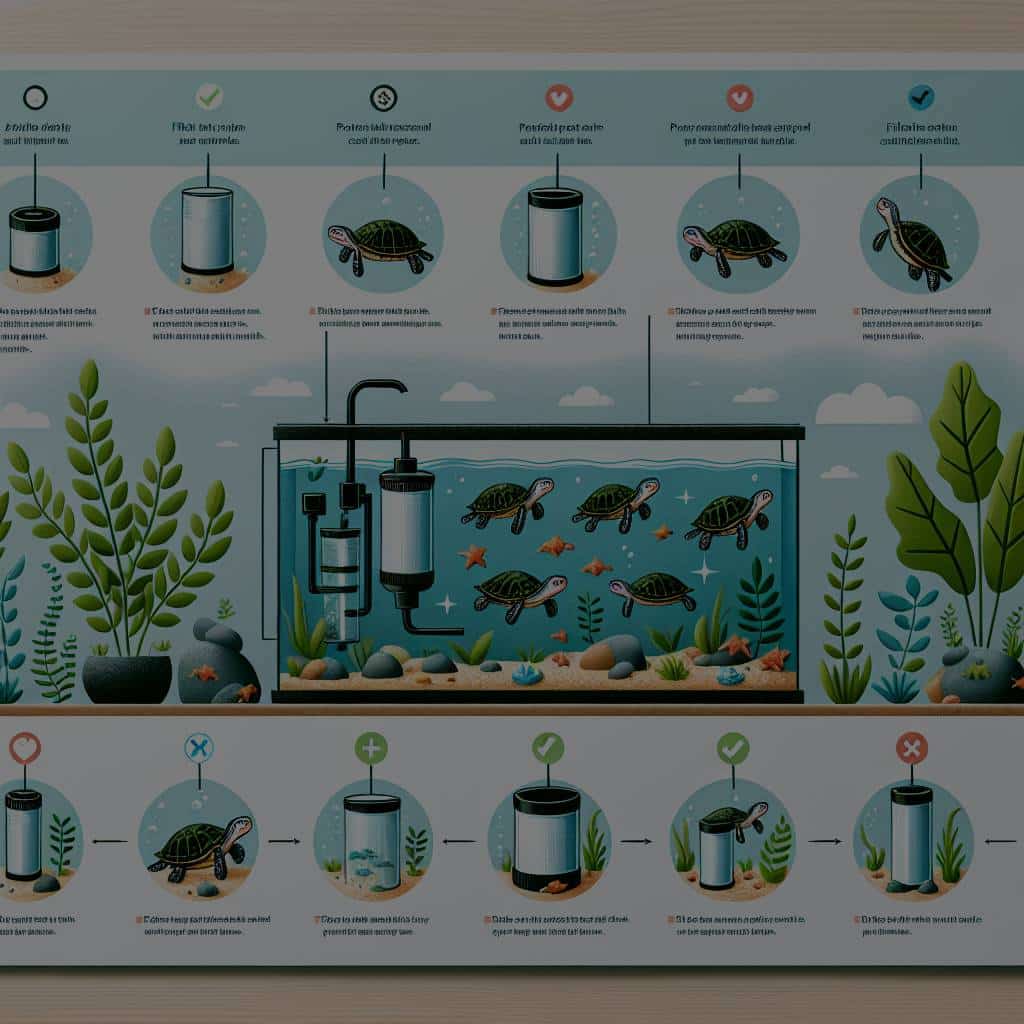How to Choose the Correct Filter System for a Turtle’s Aquatic Habitat?

As turtle enthusiasts, you understand that these unique creatures require a specific environment to thrive. One of the essential elements in establishing a suitable habitat lies in the water tank’s filtration system. Often, an incorrect or inadequate filter can lead to numerous problems, such as an unhealthy living environment, poor water quality, and overall dissatisfaction for your beloved turtle. To help you avoid these pitfalls, we’re going to delve into the crucial factors you need to consider when choosing an appropriate filter system for your turtle’s aquatic habitat.
Understanding the Importance of a Good Filter System
Before we begin, let’s comprehend why a high-quality filtration system is vital for your turtle’s tank. Unlike fish that only produce waste in the form of uneaten food and excrement, turtles are significantly more messy. They not only produce waste but also shed skin and produce a more significant amount of organic waste. This scenario calls for an exceptional filtration system to keep the water clean and safe.
Also to see : How to Teach a Dog with Limited Vision to Navigate a New Home?
A good filter will help maintain the water quality, remove waste, and ensure a comfortable environment for your turtle. Remember, healthy water equals a healthy turtle. Without proper filtration, waste can accumulate and produce harmful chemicals like ammonia, causing health issues for your aquatic friend.
Types of Filtration Systems
There are primarily three types of filtration: mechanical, biological, and chemical. Understanding each will aid in determining the best choice for your turtle’s tank.
Also to read : What’s the Best Diet for a Cat with a History of Urinary Tract Infections?
-
Mechanical filtration involves physically trapping debris and waste within the filter media. It’s the first stage of filtration and is great in maintaining clean and clear water.
-
Biological filtration is the process in which beneficial bacteria convert harmful waste products, such as ammonia and nitrites, into less harmful nitrates.
-
Chemical filtration uses activated carbon or other chemicals to remove unwanted substances from the water, like discolorations or odors.
For a turtle’s tank, a system that integrates all three types of filtration is generally the best option. It ensures the water is not merely clean-looking but also healthy.
Deciding the Best Filter Based on Tank Size
The size of your tank is a crucial factor when selecting your filtration system. Canister filters are typically considered the best for larger tanks, usually 40 gallons or more. They are powerful and efficient, offering all three types of filtration. Importantly, they can handle the high amount of waste turtles produce.
For smaller tanks, submersible filters or hang-on-back filters could be efficient. However, remember that turtles typically require more filtration than fish, so it’s advisable to choose a filter rated for a bigger tank than you actually have.
Determining the Filter Flow Rate
The flow rate of a filter refers to how much water it can process in a given time, usually measured in gallons per hour (GPH). For a turtle’s tank, you want a filter with a high flow rate. This will ensure the water is cleaned effectively and swiftly.
A good rule of thumb is to choose a filter that can cycle the entire volume of the tank at least 2 to 3 times per hour. For example, if your tank is 50 gallons, look for a filter with a flow rate of 100-150 GPH.
Considering the Maintenance Requirements
Lastly, consider the maintenance demands of the filter system. All filters require regular cleaning to continue to operate efficiently. However, some are easier to clean than others.
Canister filters, though effective, can be more challenging and time-consuming to clean. On the other hand, systems like hang-on-back filters are relatively easier to maintain. Your choice will depend on how much time and effort you are willing to dedicate to filter maintenance.
In conclusion, choosing the right filtration system for your turtle’s tank involves considerations of the tank size, filtration types, filter flow rate, and maintenance requirements. The ultimate aim is to keep the water clean and the turtle healthy.
Factors to Consider When Choosing a Turtle Filter
There are several factors to consider when choosing a turtle filter. As a turtle enthusiast, you already know the importance of a healthy habitat for your pet. A good turtle filter can maintain the tank’s water quality and prevent the accumulation of harmful chemicals like ammonia. In a nutshell, the right filtration system is indispensable for your turtle’s health.
To begin with, the type of turtle you have will play a role in selecting the right filter. Certain species of turtles, such as the red-eared slider, are known for producing a lot of waste and therefore require a more robust filtration system. If you have such a species, you will need a powerful filter, like an external canister filter, that can handle heavy loads.
Next, consider the placement of the filter. Some filters are designed to be submerged in the tank water, while others hang on the back of the tank. The best option will depend on your tank setup and personal preference.
The filter media, or materials used to perform the filtration, is another crucial factor. The choice of filter media can significantly influence the effectiveness of the filtration process. For instance, a filter sponge can provide excellent mechanical filtration and act as a breeding ground for beneficial bacteria.
Lastly, consider the noise level of the filter. Some filters, especially those with high flow rates, can be quite loud. If your turtle’s tank is in a quiet room or if you are sensitive to noise, you may want to opt for a quieter filter.
Understanding the Need for Regular Water Changes
Even with the best turtle filter, regular water changes are still necessary to maintain the quality of the tank water. No matter how efficient your filtration system is, it won’t be able to remove all the waste and chemicals that accumulate over time. Regular water changes will help keep the water fresh and safe for your turtle.
Depending on the size of your turtle tank and the amount of waste your turtle produces, you may need to change the water partially or entirely every week or two. This process can be made easier with a water changer, a device that allows you to drain and refill your tank without disturbing your turtle.
During water changes, it’s also a good practice to check the condition of your filter media. Over time, the media can become clogged with debris and lose its effectiveness. If you notice that the water isn’t as clean as it should be, it may be time to replace or clean the filter media.
You should also monitor the aquarium filter’s performance regularly. Is it still providing a high flow rate? Is it making more noise than usual? These could be signs that it’s time for a filter maintenance or replacement.
Conclusion
Choosing the right filtration system for your turtle’s aquatic habitat is a crucial task that requires consideration of several factors. From the type of turtle you have to the size of your tank, from the choice of filter media to the noise level of the filter, every detail counts. Remember, a good filter is essential for your turtle’s health and happiness.
Moreover, even the best filtration system cannot replace the need for regular water changes. Maintaining the cleanliness of the tank water is a shared responsibility between a good filter and diligent water changes. By taking these factors into account, you can create a clean, healthy, and comfortable environment for your beloved turtle.
